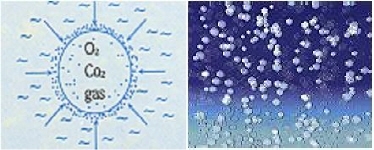



Important Properties of Ultrasonic Waves
Ultrasound is a high frequency sound above the human hearing range. Although the hearing range varies from person to person, its lower frequency limit is approximately 20 kHz in healthy, young adults. It has high acoustic energy with high pressure of sound wave which is able to penetrate any medium (solid, liquid, and gas). Utilizing its various properties deliberately, the ultrasound waves can be applied to a variety of different situations. Here, some of important properties used by the Morko USP are briefly introduced.
◆ Vibration
Ultrasound wave energy generates 12,000 to 40,000 vibrations per second. This vibration transmits rapidly into the metallic solid facilities on whose surface scale grows. The scale development onto the surface of these facilities is strongly impeded by its continuous vibration, and also already deposited scale can be removed. However, it is known that the power of the vibration is not large enough to cause mechanical fatigues to most facilities, because its amplitude is controlled less than 3㎛.
Ultrasound is a high frequency sound above the human hearing range. Although the hearing range varies from person to person, its lower frequency limit is approximately 20 kHz in healthy, young adults. It has high acoustic energy with high pressure of sound wave which is able to penetrate any medium (solid, liquid, and gas). Utilizing its various properties deliberately, the ultrasound waves can be applied to a variety of different situations. Here, some of important properties used by the Morko USP are briefly introduced.
◆ Vibration
Ultrasound wave energy generates 12,000 to 40,000 vibrations per second. This vibration transmits rapidly into the metallic solid facilities on whose surface scale grows. The scale development onto the surface of these facilities is strongly impeded by its continuous vibration, and also already deposited scale can be removed. However, it is known that the power of the vibration is not large enough to cause mechanical fatigues to most facilities, because its amplitude is controlled less than 3㎛.
◆ Cavitation
When ultrasonic vibration takes place in a fluid, numerous minute bubbles are formed in it due to fluid turbulence generated by alternating compression and rare factions of sound waves. These bubbles, due to their negative pressures, tend to suck dissolved oxygen, gases, and insoluble particles into them, causing their expansion and explosion. When they are exploded, high powers are released to the surroundings. It is known that those powers are even larger when they have resonance frequencies with transducers. By their enormously high explosive powers, scale materials are destroyed and removed.
When ultrasonic vibration takes place in a fluid, numerous minute bubbles are formed in it due to fluid turbulence generated by alternating compression and rare factions of sound waves. These bubbles, due to their negative pressures, tend to suck dissolved oxygen, gases, and insoluble particles into them, causing their expansion and explosion. When they are exploded, high powers are released to the surroundings. It is known that those powers are even larger when they have resonance frequencies with transducers. By their enormously high explosive powers, scale materials are destroyed and removed.
◆ Increase of Surface Area
If a particle in a liquid is split into smaller particles by ultrasonic waves, total surface area of the shattered particles exponentially increases. The increased surface area accelerates the destruction rate of particles.
If a particle in a liquid is split into smaller particles by ultrasonic waves, total surface area of the shattered particles exponentially increases. The increased surface area accelerates the destruction rate of particles.
◆ Acoustic Streaming
When ultrasonic energy is transferred to fluid through metal, acoustic streaming is generated in the fluid and also at the contact surface between the fluid and the metal. This acoustic streaming prevents particles and gases in the fluid from bonding to the metal surface. This improves heat circulation in the facilities and so enhances the efficiency of heat transmission. It is very effective act by ultrasound to prevent fouling or scale deposit in tube surface of heat exchanger.
When ultrasonic energy is transferred to fluid through metal, acoustic streaming is generated in the fluid and also at the contact surface between the fluid and the metal. This acoustic streaming prevents particles and gases in the fluid from bonding to the metal surface. This improves heat circulation in the facilities and so enhances the efficiency of heat transmission. It is very effective act by ultrasound to prevent fouling or scale deposit in tube surface of heat exchanger.

